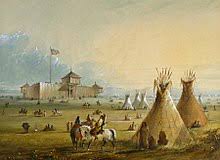The core information for this series of posts is taken from an article in the June 2020 issue of Wild West magazine. The article is titled "Worst of the Sioux Wars."
I quibble with how they break things up here and will get into that as this series develops. I will also add other information.
1) The Oregon Trail War
A well-known mid 1850's episode among western history buffs. Took place in the mid 1850's and involved a famous episode of a Mormon's supposedly stolen cow at Fort Laramie. A small army command under Lieutenant Grattan was wiped out and Lakota Chief Conquering Bear was killed.
The major fight of this conflict was the Battle of Ash Hollow in November, 1855. Colonel William Harney and 600 soldiers wiped out a Brule village.
Harney became known as "Woman Killer" by the Sioux after Ash Hollow.
I like to think of this war as the "Oregon Trail War" as pertains to the story of the Sioux. The Sioux called the Oregon Trail, the Holy Road.
Crazy Horse was present for many of the events of this conflict as young teenager when he still went by the name of "Curly."
The thought strikes me that the Brule band of Lakota often get short shrift from western history buffs, because most of them went to the reservation early; but this was largely a Brule/Oglala episode in Sioux history.
Below: Fort Laramie and adjacent Indian Village as what the scene of the stolen cow may have looked at the time..
2A) The Minnesota War of 1862
As with the other posts in this series, the core idea for this outline was taken from the June 2020 issue of Wild West magazine.
The Minnesota War of 1862 was short spasm of extreme violence in the summer and fall of 1862. Starving Dakota Sioux rebelled and killed hundreds of settlers and soldiers.
This war is also notable for the Indian attacks on fixed positions at Fort Ridgely, New Ulm, Fort Abercrombie and pitched battles at Birch Coulee and Wood Lake
This war is one that I hope to look at in several posts in the future of this blog. I have touched on it, but to fulfill the mission of The Smoke of the Sioux I have to do a deep dive on it.
The Fort Abercrombie portion of this conflict might be the most interesting to look at as most histories of the war don't say much about it.
I have shown this picture before but it highlights my personal connection to the 1862 Dakota War in Minnesota. It is a picture of the timbers of a still standing building on the homestead of one branch of my family. My ancestors escaped, but the Sioux attempted to burn the building. However, the wood was too green.
Photo by author.
2B) The War of the Columns
The Wild West article counts this conflict as part of the Dakota War in Minnesota. However, while it is an offshoot of that conflict, I consider it a separate war and I call it "The War of the Columns." This war is almost unknown, even among hard-core history buffs as it was drowned out by the Civil War. I call it "The War of the Columns."
In the aftermath of the Minnesota 1862 War (The Dakota War); Army columns were sent out onto the Dakota plains in 1863 and 1864, and to a lesser extent in 1865; to punish those Indians responsible for the violence and who had escaped to the western plains.
I consider "The War of the Columns" to be separate from the Minnesota War because all three branches of the Sioux became entangled in it. The Dakota, Nakota and Lakota all played a role.
It is notable that some of the engagements in the War of the Columns may have had the largest number of combatants of any battle in the Indian Wars.
The 1863 fighting took place east of the Missouri River, in what is now North Dakota and the 1864 fighting happened west of the Missouri River, also in present-day North Dakota.
In an early post on this blog, I said that I consider North Dakota to be the central focus of Sioux history in the frontier era. The War of the Columns, in addition to the post immediately prior to this on the Sioux struggle against Fort Buford in North Dakota illustrates my point.
Of all the Sioux conflicts, I consider this to be my "favorite" possibly because it flies under the radar of western history.
"Columns of Vengeance" is a recent book about this episode in frontier history.
The photo below was taken at Killdeer Mountain which was the site an 1864 battle. Photo by author.
2C) The Sand Creek War






No comments:
Post a Comment